|
|


 |
 |
 |
 |
Venice, rising from her waters, is like no place else on earth.
The quite particular atmosphere of this city with its warm and humid climate has greatly influenced techniques of artistic expression. The flourishing trade that earned it the name of "Empire" at the time served to foster creative effervescence in all artistic fields, giving rise to many new talents. |
 |
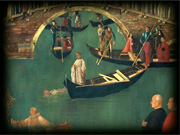 |
|
 |
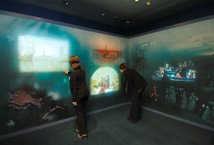 |
 |
In the Museum Lab space, images diffused by three projectors drift over the walls to recreate sixteenth-century Venice. Visitors can therefore step directly into the artwork's universe. |
|

 |

 |
 |
 |
 |
The naturalism of the Venetian school brings together religious motifs and rural landscapes. Yet in order to appreciate the full range of the subtlety and charm of The Madonna of the Rabbit - recognized as a representative work of this school - it is important to grasp the symbolic significance of its motifs.
In a spellbinding commentary with magical images, Mr.Jean Habert, curator at the Musée du Louvre and expert on sixteenth-century Italian painting, reveals the work's secrets one by one. |
 |
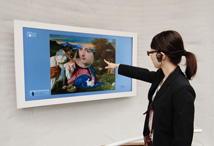 |
|
 |
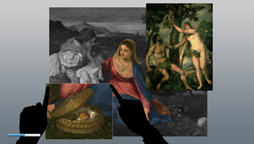 |
 |
Through Mr. Habert's explanation of the system of values that prevailed in Venice at the time—ones quite unfamiliar to someone of our day and age—visitors are able to understand the significance of each motif and to appreciate the full import of the lyrical beauty emanating from the composition and the portrayal of nature.

 |
|

 |

 |
 |
 |
 |
 |
 |
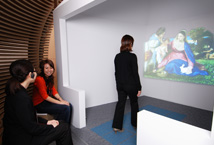 |
 |
The images projected on three sides recreate the scene depicted in The Madonna of the Rabbit. In this space orchestrated as a stage set visitors can move around at leisure—backwards, forwards, to the right or left—for a physical appreciation of notions of depth of field, lighting, and composition. They are literally borne up into the painting itself.
Visitors can enjoy a delightful stroll taking in the relative positioning of the motifs and the artistry of the composition as a whole, and are filled with wonder at the beauty of the scene. |
|


 |
 |
 |
 |
Museum Lab offers multimedia displays that are deliberately easy on the eye. The visuals presented take the form of an image projected onto a transparent glass pane merging as if superimposed upon the Museum lab garden through a glass window.
Bellini, Giorgione, followed by Titian. Lulled by the murmuring sounds of water, visitors discover the various representations of nature in sixteenth-century Italian paintings. |
 |
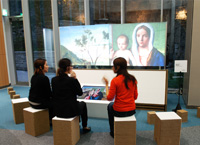 |
|

 |

 |
 |
 |
 |
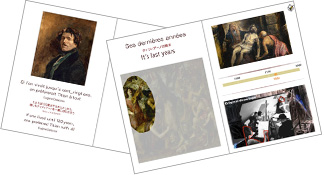 |
 |
Titian greatly influenced the creative perceptions of several generations of artists and is also known to have lived to a ripe old age. The Madonna of the Rabbit is one of his earlier works. |
|
 |
Through mixed media consisting of images projected upon a printed book, Titian himself in a first-person narrative tells visitors about the relations he entertained with other painters throughout his life, various anecdotes linked to his works, and the vicissitudes of his art up until his last works.
The images are projected in close correlation with the printed sections of the book using image recognition technologies. Visitors can therefore simply turn the pages in the usual way and enjoy reading at their own pace. |
 |
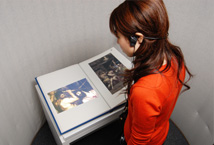 |
|

 |

 |
 |
 |
 |


 |
 |
When you look at the painting The Madonna of the Rabbit how does your gaze travel over it? Museum Lab has made it possible for each visitor to view the trajectory of his or her gaze and to see how long it lingered on any particular detail. An eye-tracking technology using an infrared camera that captures the movement of the pupils provides a diagram of how each visitor observes the painting.
In this presentation, visitors can compare their eye tracks before and after listening to the painting's commentary. The results can be seen on the area of the Website reserved for "My Museum Lab" members. Visitors can also enjoy comparing their eye tracks with that of Mr. Jean Habert. Website registration is free. |

 |

 |

 |
 |
 |
 |
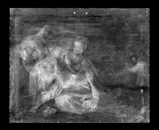 |
 |
Various aspects of the scientific examination of The Madonna of the Rabbit undertaken by the Musée du Louvre at the Center for Research and Restoration of the Museums of France are presented here. This type of investigation, generally conducted on works to be restored, provides a view of the current state of a painting, while also revealing its hidden facets. This analysis was conducted from various angles using ultraviolet and infrared photography and radioactive rays.
The examination revealed an earlier composition that is quite different from The Madonna of the Rabbit as we see it today. Notable differences are apparent in the symbolic figures of the Madonna and the rabbit.
A program of still images of very high definition charts the changes Titian made to the work at various stages in its creation. |
|
|

